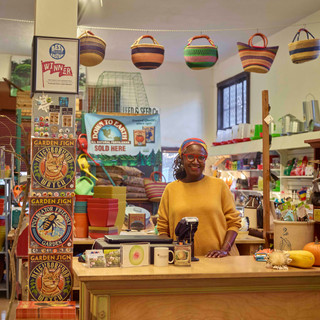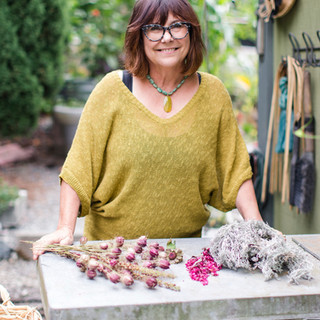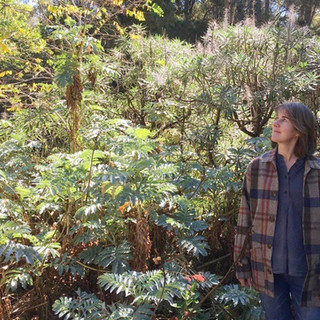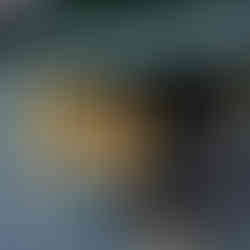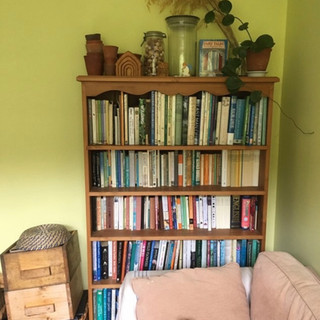
Wait - did you ask for a good garden book recommendation?
The holidays and end of year are upon us – and with them, all those lists. Things to do, food to cook, intentions to make, gifts to consider. In gifting area of life, in my experience - gardeners and plant lovers are pretty easy, they don’t want much and as long as you put some thought into it and it’s garden themed – you’re pretty safe. Plants, books, seeds, subscriptions, and good garden gear make it hard to go wrong - to bring holiday cheer, to offer as thanks when visiting someone’s home in this festive time, or to help bolster your or their New Year’s Resolutions in the garden or on the trail. Garden Books are a perennial favorite - but can get tricky - which ones are good, which ones are innovative, which have stood the test of time? This week, I’ve gathered a handful of gardeners from ranging interests and locales to offer some thoughts on Garden books that catch their eyes and imaginations this season. My guests today are all gardeners, cooks, mothers, and creatives. Yolanda Burrell is owner of Pollinate Farm and Garden Supply in Oakland, California, Lorene Edwards Forkner of Seattle, Washington is Editor of the Pacific Horticulture magazine, and Pen Pender is an avid gardener and garden book reader in Mt. Macedon, Australia. Welcome to you all - thank you for participating in the first ever Cultivating Place book club (as it were)!
There are many layers and types of garden books - the how tos, the regional, the literary, the monographs, the glossy, lovely coffee table picture books and of course there are cross-over books such as garden cook books, garden crafts, etc….. I started by asking each of you to choose 2 books you’d like the world to know more about and then 3 runner’s up to add to add to the mix.
ALL TITLES IN GREEN ARE DIRECT LIVE LINKS TO BUY THE BOOK AT INDIEBOUND
and generate support for the production of Cultivating Place.
Yolanda's Book Recommendations
My favorite gardening books are those that I can use as a reference or how-to guide. These books are typically full of beautiful color photos, are well organized, have a comprehensive index and are peppered with accessible hands-on projects to improve my garden space.
A good portion of my work at Pollinate Farm and Garden includes teaching and inspiring gardeners of all skill levels to grow more food. This can range from apartment dwellers experimenting with culinary herbs on a windowsill to school and community gardeners wanting to maximize crop production, to urban renters and homeowners who prefer more "groomed" ornamental landscapes with delicious and gorgeous edibles tucked in.
At home and at the farm store, my garden is my laboratory, and I am all of these gardeners. My style is to look at pictures, dream, reference, and then go out and get 'er done!
My go-to books focus on various styles of food gardening in the Bay Area where we are blessed within an amazing Mediterranean climate, enabling us to grow edibles year-round.
My top two books:
by Colin McCrate and Brad Halm
This book ticks all the boxes for me: as accessible cover-to-cover reading or as a reference, it has wonderful photos of veggie gardens and it is a great book for the beginner. It has sections on soil building, irrigation and container gardening.
It's also filled with how-to projects like constructing a raised bed, hooking up a drip irrigation, and building a vermicomposting system. The book has a compendium of common crops, a general planting calendar and an extensive troubleshooting section for pests and diseases.
Whether you have a lot space, a pocket garden or grow in containers - this book has suggestions on how to grow your best garden. I recommend this book a lot to my customers because it's just right!
by Christopher Shein
For those with a different aesthetic, or who are interested in learning more about ecological veggie gardening, I love The Vegetable Gardener's Guide to Permaculture by Bay Area permaculture instructor Christopher Shein. Shein takes us through the fundamentals of permaculture gardening— using ecological gardening and indigenous land practices— to grow food. The book explores basic permaculture principles and shows both the beginner and seasoned vegetable gardener how to work less hard to produce organic vegetables while reusing and conserving nature's resources.
This book is useful and a wonderful resource whether you grow on a balcony, rooftop or in the ground. It is different because in addition to growing annual vegetables it includes lots of information about perennial edibles, fruit trees, cover cropping and introduces the concept of a polyculture food forest garden. Different from growing "row crops" for moderate to high production, this traditional system is beautiful and surprisingly productive for a family or shared community space, making use of the multiple symbiotic relationships from fungi and microbes to the growing canopy to provide a sustainable and nature-friendly food source.
It is filled with wonderful color photos and illustrations. Projects in this book include soil building and composting, rainwater catchment, sheet mulching, grafting and propagation and even a section on edible weeds!
Shein's book will expand the scope from your own garden to the broader landscape and makes you very mindful of the the impacts that our local agricultural practices have on the earth.
Runners-up:
by Ivette Soler
This book is great for anyone who wants to get rid of the front lawn and grow for color, design and flavor! The Edible Front Yard was one of the first books I used when learning about Fritz Haeg's Food not Lawns movement. Food farming and curb appeal don't have to be mutually exclusive! Packed photos and projects, this book is suited for typical urban or urban residential plots.
by Novella Carpenter and Willow Rosenthal
Another local favorite! What this book lacks in color photos it makes up in scrappy practicality! Filled with illustrations and charts, this phone book (remember those?) -thick tome is a wonderful reference for those who want to dip a toe into urban farming and learn the fundamentals of growing vegetables and fruit trees as well as add egg, meat, and honey production to their self-sufficiency mix. Carpenter and Rosenthal are nothing if not budget-minded. They show you how to source materials locally and often for free (have you read Farm City?). The appendices include even more resources for urban dwellers who want the best of both worlds.
by Pam Peirce
All gardening is local. Your food should be, too! Another local favorite by San Francisco Chronicle columnist and Pollinate Farm & Garden guest instructor Pam Peirce, Golden Gate Gardening is a well-written reference, guide and recipe book containing information about well-tested and favorite varieties of fruits, vegetables, herbs and flowers. While it may be a bit deep for the absolute beginner, the book contains information on a number of great topics, such as microclimate temperatures, crop rotation, bacterial diseases and even an appendix of pesticide ingredients and effects. If you enjoy geeking out on details but still want to have time to get in the garden, then this book is for you!
Lorene's Book Recommendations:
by Thomas Rainer & Claudia West
Inspired me to loosen my grip on the garden and think more like nature: plant-driven, crowded, rambunctious, and buzzing with lots and lots of LIFE. I’m lucky that I’ve also had the chance to hear both of the authors speak and their enthusiasm is infectious—in person and on the page. In Claudia’s forward to the book she writes: “Nature is tough, tenacious, and buoyant and it is never too late.” I love that optimism and the empowerment that as gardeners, how we manage our plots can help heal the planet. This is my guidebook. Lots of beautiful photos and just as important, plenty of hardworking information that is carefully and clearly communicated. So good!
I’m always up for a good craft experiment and natural plant based dying has been very popular for the past several years. But Sasha opened my eyes to the fact that our landscapes have a signature color palette. I’m such a color geek. The idea that this garden, on this day, can be captured in unique colors blew my mind. What a beautiful way to mark a baby’s birth, or any sort of important occasion! This book introduced me to yet another type of relationship I can have with my garden. Again, I was lucky to attend a workshop led by Sasha – in fact I got to be her assistant~ Which led me to grow a crop of Japanese indigo. I wish I could say that dye project was a success but mostly I’m in it for the process and exploration. I’ve had much better luck with avocadoes – you get the most lovely coral peach color.
Runners up:
by Scott Calhoun
Everyone loves a good road trip escapade. This book recounts a “plant-mad” gardener’s adventures as he follows wildflower blooms throughout the southwest—complete with personal details like what he was driving, miles covered, who he was with and where they ate—even what music he was listening to!
There’s a terrible, bleak beauty in the windswept seaside garden of filmmaker Derek Jarman. This book showed me that the act of arranging natural elements and working with native plants, even in a landscape that many would consider desolate, can be a creative act of garden making. Jarman’s garden emerges from carefully arranged stones, flint, driftwood, and seashells. Dog roses, screaming red Flanders poppies, and resilient sea kale survive the demanding conditions, thriving even as Jarman’s health fades.
This book is, and always will remain, a sentimental favorite as it was on Ms. Perenyi’s strong opinions, erudite language, and blunt admonishments, that I first honed my horticultural reading chops. As Ms. Perenyi wrote in the forward where she demurred about her garden expertise: “...a writer who gardens is sooner or later going to write a book about the subject—I take that as inevitable.”
"a plant driven, crowded rambunctious garden that’s filled with life is kind of the ideal we’re after, Thomas said one time that More life breeds more life, the more we plant living things, the more we attract living things, which generally improves our life, which is all this beneficial circle.”
Lorene Edwards Forkner, Editor Pacific Horticulture
on "Planting in a Post-Wild World" by Thomas Rainer and Claudia West
for CP's Holiday Garden Book Round Up.
Pen's Book Recommendations:
by Matt and Lentil Purbrick
I have chosen it because they are from Australia but the information can be applied anywhere. It also sets itself apart for me from other gardening books as it speaks about the importance of community wether thats a family, a neighborhood, village etc and I felt that my village includes my family, farmers market, my friends, my garden, my insta friends it can be as varied and as wide as that. The gardening information is very helpful and wise with lots of charts and info. It encourages us to embrace the chaotic side of gardens and life too which I really like! It has some beautiful photographs and great recipes including how to make kombucha. Think this would make a great gift.
I have chosen this book as it is really making me think about how I garden. It is a conservation project in the UK but the lessons in this can be applied to gardens everywhere. It seems that happily the idea of ecological gardening is becoming more mainstream and the results of managing the landscape in this way are proving incredibly positive. Feels timely to have proof of a different type of cultivation that can make a difference.
Runners up:
A beautifully illustrated book with thoughtful commentary by Monty Don, a great Christmas present!
An interesting book with beautiful photographs. Made me appreciate the skills of the head gardeners and how unfortunately horticulture is undervalued in our society when in fact it is such an important skill.
A really great read, fascinating. Broad spectrum of plants people across history.
Follow Yolanda's work and garden journey:: https://www.pollinatefarm.com/ and @Pollinatefarm
Follow Lorene's work and garden journey: www.pacifichorticulture.org and @gardenercook
Follow Pen's work and garden journey:: @penpender
And you may be wondering what I would suggest to you for good books this year. As you are no doubt aware - I read A LOT. And a great deal of it for this work/passion I love. You've heard a lot about garden books I have been taken by this past year but if I had to recommend TWO to you this coming season - for your head and your heart and this world - hands down these would be them:
This book took my breath away. I loved every page of it.
If you haven't read this book, consider this a homework assignment, if you have, you should probably read it again. I have read three times these past few years and there's always more to catch.
Happy happy reading.....
The #campfire is just one instance of natural disaster and hardship in a world full of them. And as I wrote in the invite I sent out to gardeners for this open house, we all do the best we can to help where we are. I am here. Thank all of you who’ve helped. In the midst of this, I’ve had so many notes of support and reflection – on perspective and priorities. This one stood out to me from Megan in South Africa, she will be a guest on CP towards the end of the month talking about her project Turning Into Flowers. She wrote:
“In the past week some of the areas we filmed in this year have burned. The relationship between the California fires and the ones out here has been at the top of our hearts.
One of my favorite hopeful moments this year was a message and photo from Rupert. A mutual friends farm that burned in 2017 had suddenly come alive with flowers last seen 23 years ago. Rupert took his little daughter to go and see the ashy moonscape coming back to life. I'm holding tight to that memory. This year's fire season is just beginning out here and its already devastating.
The knowledge that many fynbos species need fire to germinate, and to clear old growth somehow tied in, for me, to your incredible appeal and the amazing responses to your Campfire Gardeners initiative. Somehow, in the heart of this climate change driven devastation, new growth is possible and communities come together not in spite of the loss, but inside it.”
Hold that – because in my opinion all of our gardens, and us as gardeners are part of that: we are growth possibility and our vast community coming together NOT in spite of life or loss – but inside of it.
There’s one of my New Year’s Resolutions for us all. Would love to hear yours! If you feel like it – please share in the comments on Instagram or Facebook or by sending me and Sarah a note – cultivating place @ gmail.com. We love to hear from you. You listening and responding with your stories or comments and feedback are like a drink of water, and a shot of organic compost for Cultivating Place. I kid you not.
WAYS TO SUPPORT CULTIVATING PLACE
Shop at Indiebound:
Interested in buying any of the books listed above AND in supporting Cultivating Place? Purchase them at Indiebound.com through the links in the green titles of ALL the books above - you'll support independent bookstores, the authors, and for every purchase made through the direct links above (the green titles are live links), a small donation comes back to Cultivating Place. Which is a win-win-win. :)
DONATE: Cultivating Place is a listener-supported co-production of North State Public Radio. To make your tax-deductible listener contribution – please click the donate button below. Thank you in advance for your help making these valuable conversations grow.
Or, make checks payable to: North State Public Radio - Cultivating Place
with Cultivating Place in the memo line, too
mail to: California State University, Chico
400 W. First Street
Chico, CA 95929-0999




